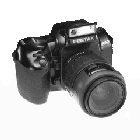

The f-Stops Here
A series of columns on outdoor photography
Why Not Shoot Yourself?
by Sharon Watson
 If you have a devoted outdoor photographer in your family, you've probably
noticed your album are full of great Idaho memories, but very few of the
photographer himself or herself. If you ARE that photographer, it gets
annoying never to see yourself in action. The problem can be remedied
somewhat with a few self-portrait techniques.
If you have a devoted outdoor photographer in your family, you've probably
noticed your album are full of great Idaho memories, but very few of the
photographer himself or herself. If you ARE that photographer, it gets
annoying never to see yourself in action. The problem can be remedied
somewhat with a few self-portrait techniques.
When I finally get that trophy bull elk I've been hunting for, do you think
my hunting partner will be around to take the picture? Probably not! The
only way I'll have a photo of the event is to take it myself. I won't have
toted a tripod, so hopefully I'll have an alternative: a nearby stump,
rock, or pile of dirt on which to set my self-timed camera. A stuffed
duffle bag, shoulder bag, fanny pack, or small backpack might also be used
for this purpose. If like us you carry large plastic bags for hauling out
meat, try filling one with leaves or forest duff to build up a platform.
Another option is a C-clamp/camera mount combination for attaching cameras
to tree limbs.
It's near-certain I'll cut my head out of the picture if I'm not careful,
so a stick placed at the right height will let me check for head room. It
will also give me something to prefocus on, assuming I can quickly place my
grinning face in about the same spot. A precaution: Because your eye is not
behind the viewfinder, excess light coming through the now-open viewfinder
can confuse the camera's automatic light metering. For self portraits, it's
best to cover the viewfinder or manually set the correct exposure in
advance.
Self-portraits come in two styles. One is taking a picture of yourself
taking a picture of yourself. The other, with the use of a tripod, looks
like someone else took the picture. Within these two viewpoints is plenty
of room for creativity.
With camera on a tripod off to one side, try shooting a reflected image of
yourself, free, for once, of the camera itself - in the side of a shiny
pickup, say, or in a mirror hung on a tree in deer camp. Incidentally, an
advantage to super-stable tripod shooting is you can use smaller f-stops
and slower speeds, allowing a greater depth-of-field safety margin.
When shooting yourself without benefit of tripod, try for your
camera-wielding reflection in the eye of an animal, in your buddy's
sunglasses, or in a still mountain lake. An offbeat variation on a bright
day is to capture your sharply-focused shadow holding bird or fish.
In Idaho's outback night, the "Bulb" setting on some cameras can be used to
get yourself in the picture. This setting locks the lens open, but with
slow film, small f-stops, and little light, the picture forms very slowly
or not at all. A hand-held flash used manually on yourself will fill the
frame nicely! Move around in the picture and flash yourself several times
for a creative multiple-image shot. Then go close the shutter.
Most of the time outdoor photographers are properly and happily lost in
gathering visual images from "out there" in Idaho's beautiful mountains and
deserts. For a refreshing change, turn the lens on yourself now and then
and give yourself the present of a nicely posed and executed self-portrait.
Other Resources:
Shooting the Hunt
Kids in the Outdoors
OUTDOOR PHOTOGRAPHY BOOKS:
Natural Light
By Jim Zuckerman
The Art of Outdoor Photography
By Boyd Norton
Mountain Light
By Galen Rowell
L. L. Bean Outdoor Photography Handbook
By Jim Rowinski, Kate Rowinski
Nature's Tranquility: Reflections and Insight
By Tom Klein, editor
How to Photograph the Outdoors in Black and White
By George Schaub

 If you have a devoted outdoor photographer in your family, you've probably
noticed your album are full of great Idaho memories, but very few of the
photographer himself or herself. If you ARE that photographer, it gets
annoying never to see yourself in action. The problem can be remedied
somewhat with a few self-portrait techniques.
If you have a devoted outdoor photographer in your family, you've probably
noticed your album are full of great Idaho memories, but very few of the
photographer himself or herself. If you ARE that photographer, it gets
annoying never to see yourself in action. The problem can be remedied
somewhat with a few self-portrait techniques.